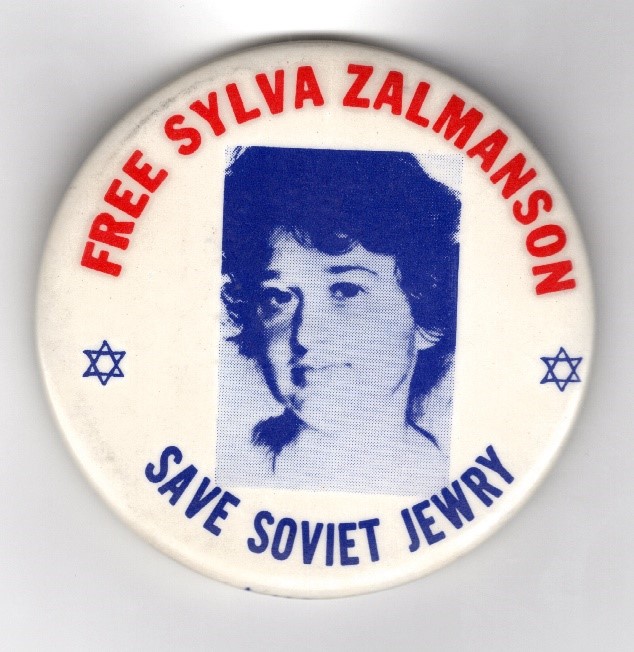
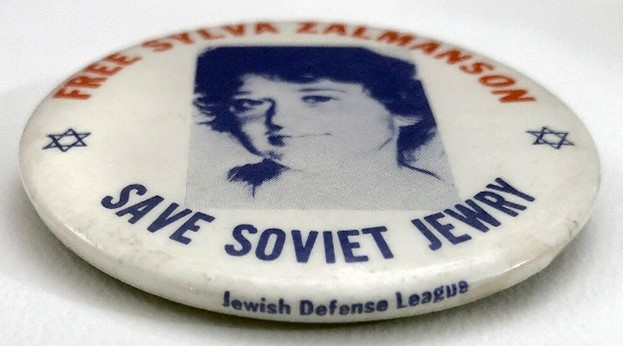
During the fight of the Western public for the rights of Soviet Jews to live according to their traditions and for the right to repatriate to Israel, a significant role was played by the actions aimed at liberating those imprisoned in Soviet prisons and labor camps—known as the “Prisoners of Zion”. These individuals lost their freedom due to their desire to return to their historical homeland and unwavering struggle for this cause [1]. The Soviet Jewry Movement organizations organized demonstrations and rallies to support these people and provided material assistance to them and their families. The badges produced by these organizations became symbols of resistance, solidarity, and hope. Today, these items serve as a unique archive of stories and the names of those who stood on the front lines fighting for Soviet Jewry. They resurrect the memory of those who boldly advocated for the rights of Soviet Jews. Previously, the author wrote about the “Let My People Go” medallions [2 and 3], which were dedicated to the following prisoners of Zion: Anatoly Altman, Boris Azernikov, Yuri Brind, Hillel Butman, Shlomo Drezner, Mark Dymshits, Anatoly Goldfeld, Lassalle Kaminsky, Leib Khnokh, Mikhail Kornblit, Valeri Kukui, Eduard Kuznetsov, Semion Levit, Vladimir Markman, Iosif Mendelovich, Rayza Palatnik, Boris Penson, Yuri Vudka, Israel (Izia) Zalmanson, Sylva Zalmanson, и Wolf Zalmanson. These medallions were distributed alongside leaflets urging help for the prisoners and their families. In this article, the author describes the badges and medals known to him, issued by human rights organizations in support of specific Jewish political prisoners in the Soviet Union. This current piece continues the author’s papers describing and categorizing badges and medals related to the struggle for Soviet Jewry [2 - 8].
An entire group of various badges is dedicated to those Soviet Jews whom the Soviet court convicted in connection with the "Dymshits–Kuznetsov airplane hijacking affair", also known as “The First Leningrad Trial” or the “Operation Wedding”. It was an attempt to take a civilian aircraft on 15 June 1970 by a group of 16 Soviet Jews to escape to the West. Even though the effort was unsuccessful, it became a notable event during the Cold War because it drew international attention to human rights violations in the Soviet Union and resulted in the temporary loosening of emigration restrictions.
In articles [2 and 3] we have described medallions dedicated to Silva Zalmanson. Here we show in figures 1 and 2 badge in her honor issued by the Jewish Defense League, the radical human rights organization.

|

|
Fig. 1 Badge with a diameter of 6.5 cm.
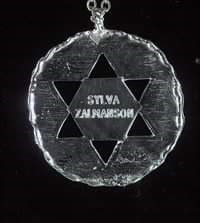
|
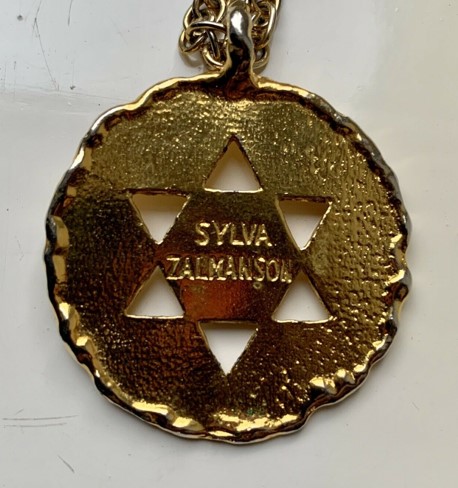
|
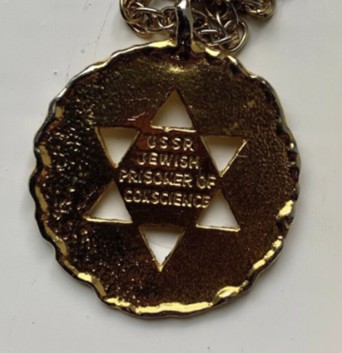
|
Fig. 2 Medallions with a diameter of 3.5 cm.
The medallions in figure 2 were made in silver and gold colors. The appearance of medallions dedicated to Sylvа Zalmanson is associated with the organization ‘Group 35’ [9, 10] and the name of the famous Swedish actress Ingrid Bergman. ‘Group 35’ was organized in the United Kingdom during the trial of 35-year-old Reiza Palatnik, a librarian from Odessa who was convicted of Zionist activities. Initially, the group consisted of 35 British housewives, all about 35 years of age, who, upon the advice of Itzhak Rager, the London emissary of the Israeli ‘Nativ’ - Liaison Bureau, that maintained contact with Soviet Jews, decided to fight for Reiza. ‘Group 35’ received support from the well-known actresses Jane Fonda and Ingrid Bergman. In March 1973, ‘Group 35’ invited Ingrid Bergman to London to draw public attention to Sylvа Zalmanson’s difficult situation. Ingrid Bergman actively participated in the fight for Sylvа Zalmanson. Georges Weil, a world-renowned jeweler, designed a medallion with Sylva’s name engraved inside the Star of David. Hundreds of these medallions were reproduced in silver, and a few special orders were made in gold. Ingrid Bergman was presented with a gold version. Many medallions were also made from non-precious metals, and painted in silver and gold color.
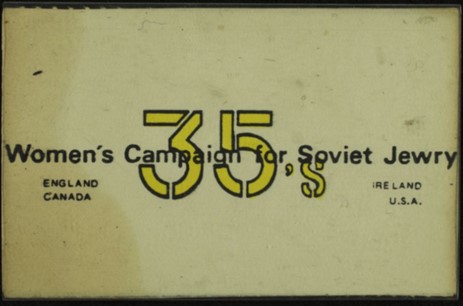
|
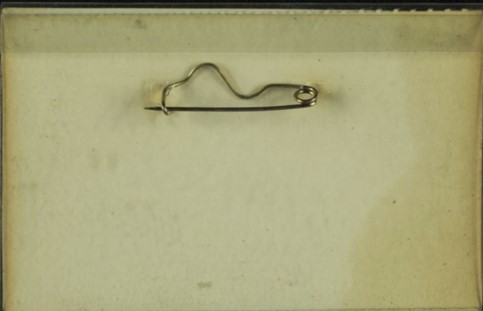
|
Fig. 3 “Group 35” badge

Fig. 4 Ingrid Bergman with a medallion in honor of Sylva Zalmanson (photo from work [11])
There is another badge (Fig. 5) dedicated to the prisoner of Zion Zalmanson, which, according to the author, can be attributed to any of the three Zalmansons convicted at the First Leningrad Trial.

Fig. 5 Badge size 2.5x2.5 cm.
The badges shown in Figures 6 – 9 are dedicated to Altman, Kuznetsov, Mendelevich, and Penson, respectively, convicted in the “airplane case”.

|
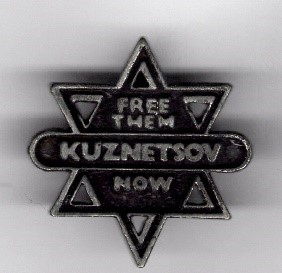
|
| Fig. 6 Badge size 2.5x2.5 cm. | Fig. 7 Badge size 2.5x2.5 cm. |
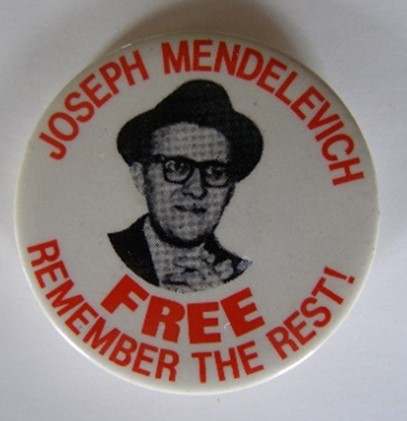
|
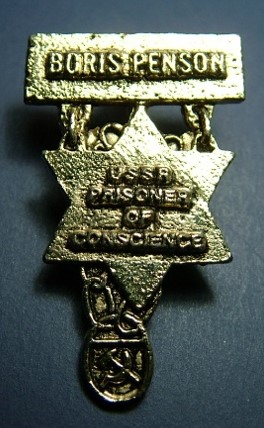
|
|
Fig. 8 Badge with a diameter of 5.5 cm. The badge was issued by the organization “Student Struggle for Soviet Jewry” (SSSJ) |
Fig. 9 Badge size 2x3.5 cm. |
The following group of badges and medals (Figs. 10–13) are dedicated to prisoner Zion Natan (Anatoly) Sharansky (Shcharansky). Natan Sharansky was born on January 20, 1948, in Donetsk, in the family of to journalist Boris Sharansky and economist Ida Milgrom. He studied at the Moscow Institute of Physics and Technology and graduated in 1972. After completing his studies, he worked at the Institute of Oil and Gas in Moscow. Following a denial in 1973 to emigrate to Israel, motivated by security concerns, Sharansky became one of the leaders of the Soviet Jewish refusenik movement. He authored numerous letters a.nd appeals from Jewish activists to Soviet authorities and the international community regarding human rights violations, particularly those affecting Jews in the USSR. Sharansky was one of the initiators of the Moscow Group for Monitoring Compliance with the Helsinki Accords in the field of human rights, known as the Helsinki Group. On March 15, 1977, Sharansky was arrested on charges of espionage and treason against the homeland. On July 14, he was sentenced to 13 years of imprisonment. His harsh sentence, courageous behavior during the investigation and imprisonment, and an active campaign for his release—where his wife, Avital Sharansky, played a significant role—made his name known worldwide. Mass rallies and demonstrations in support of Sharansky were held in the United States, Israel, and other Western countries. Special badges were produced and worn by participants in these protests.
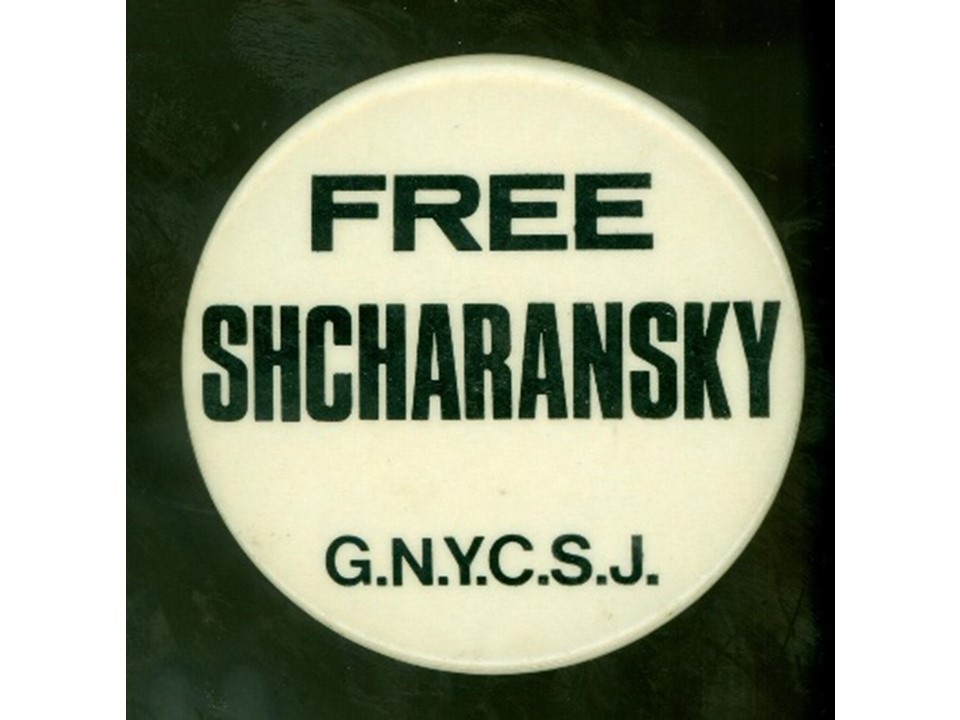
Fig. 10. Badge “FREE SHCHARANSKY” (a diameter of 4.5 cm), The badge was issued by the organization “The Greater New York Conference on Soviet Jewry” (G.N.Y.C.S.J.).
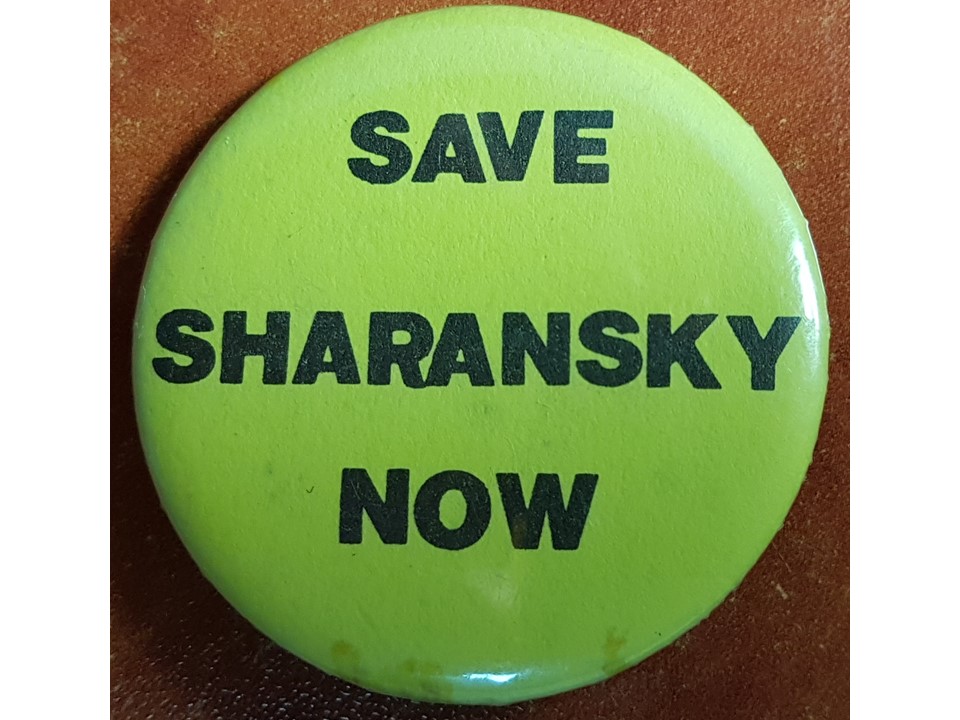
Fig. 11. Badge “SAVE SHARANSKY NOW” (a diameter of 4.5 cm).
In 1983, the Magnes Museum commissioned a medal from the renowned medalist Alex Shagin, who had emigrated to the United States from the Soviet Union. The medal was dedicated to Anatoly Sharansky [12]. On the obverse of the cast medal is a profile of Sharansky (Shcharansky) and his name. The reverse side depicts a solitary figure surrounded by high walls, symbolizing not only Sharansky’s physical confinement but also the oppressive nature of life in the communist state. The artist included a hint of hope by showing an open sky above the walls, and to give this symbolic meaning, it is depicted in a hexagonal shape reminiscent of the Star of David. The medal has a diameter of 4.5 inches (11.43 cm) and a total of 250 medals were produced, each with a unique serial number.
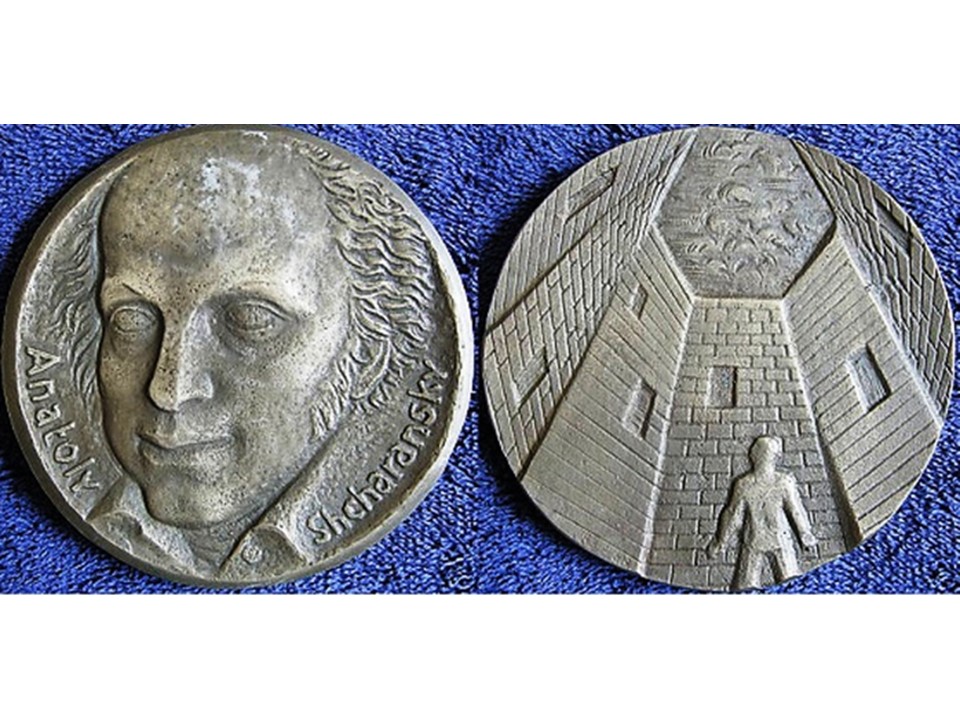
Fig. 12
After international pressure and demonstrations on February 11, 1986, Sharansky was released from prison. He was stripped of Soviet citizenship and exchanged on the Glienicke Bridge, which connected West and East Berlin, for a Soviet spy arrested by the Americans. Sharansky immediately flew to Israel.
In 1986, both Natan Sharansky and his wife, Avital, were awarded the Congressional Gold Medal in the United States for their dedication to the cause of human rights. The article by Jack H Fisher provides detailed information about this medal [13]: “President Reagan presented two Congressional Gold Medals to Natan Shcharansky who accepted them in on behalf of his wife, Avital, and himself, at a White House ceremony on January 11, 1989. The Act of Congress is Public Law 99-298 that sets forth that the medals are in recognition of Natan and Avital Shcharansky's "supreme dedication and total commitment to the cause of individual human rights and freedom". The obverse of the medal features the portraits of Natan and Avital Shcharansky. Their names are inscribed around the outer edge of the medal. It is noted that below the portraits are the words, "Act of Congress May 13, 1986". The reverse of the medal depicts the Wailing Wall in Jerusalem where people assemble for prayer and lamentation. The phrase, "Let My People Go", in Hebrew, Russian, and English appears beside the representation of the Wailing Wall on the medal. There is inscribed around the outer edge, the words, "Freedom of Thought, Conscience, Religion ... Helsinki Final Act." This medal recognizes that Mr. Shcharansky was a prominent founding member of the Moscow Helsinki Monitoring Group. The obverse design of the medal was designed and executed by Mr. James Licaretz, Sculptor/Engraver, United States Mint. The reverse themes of the medal were suggested by the Shcharansky family and friends, which were incorporated in the reverse design of the medal designed and executed by Mr. James Licaretz. ” The bronze duplicate medals of the Congressional Gold Medals honoring Natan (Anatoly) and Avital Shcharansky were issued in a three-inch size (7.62 cm) and one-half-inch size (3.81 cm).
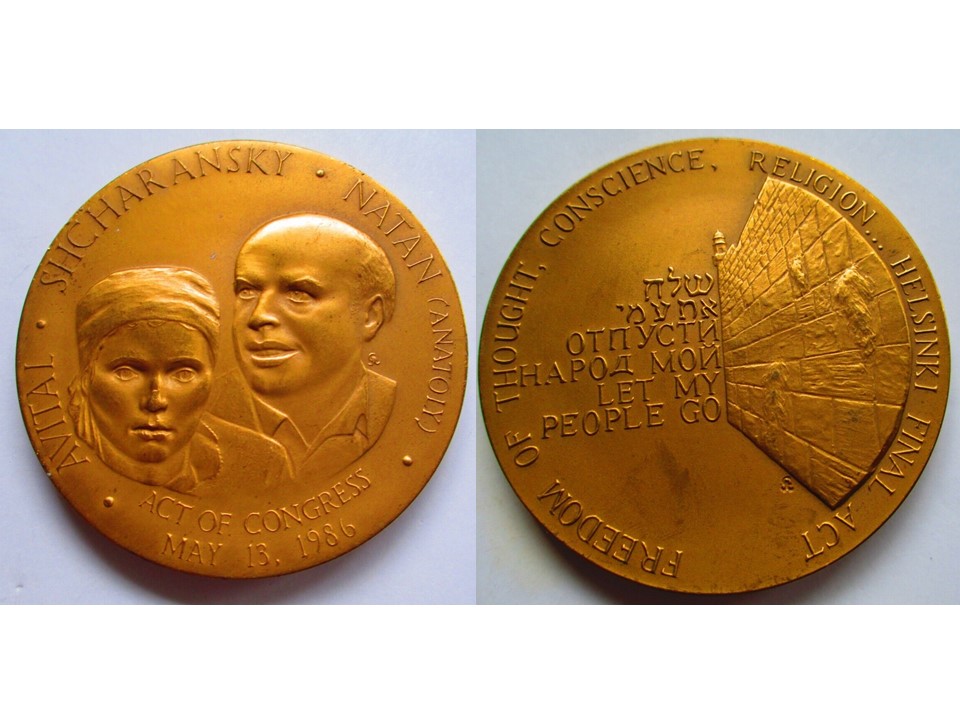
Fig. 13
The following 5 badges (fig. 14 – 18) are dedicated to five prisoners of Zion, whose brief biographies were borrowed by the author from the Remember and Save Association website [14].
Hillel Butman was born in 1932 in Leningrad. He was a prominent activist in the Jewish national movement in Leningrad during the 1950s and 1960s. In 1969, Butman began teaching Hebrew to Jewish youth groups after independently studying the language. He organized ulpanim (Hebrew language classes) with friends, focusing on Hebrew, Jewish history, and traditions. On June 15, 1970, he was arrested on charges related to his involvement with an underground Zionist organization, distributing anti-Soviet Zionist literature, and participating in the initial planning of an airplane hijacking and escape to Israel. He was sentenced to ten years in a strict regime labor camp. Butman was released in 1979 and repatriated to Israel in the same year. He published autobiographical books in Russian, which were later translated into Hebrew and English. He passed away in May 2019.
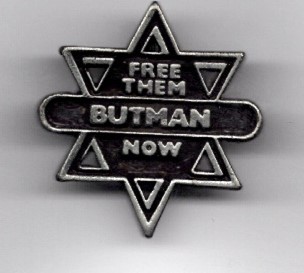
Fig. 14. Badge size 2.5x2.5 cm.
David Chernoglaz (Maayan) was born in 1939 in the city of Pushkin, Leningrad Oblast. In his early youth, he rejected Soviet ideology and lifestyle, turning to Zionist beliefs. Between 1958 and 1960, he organized a student circle focused on studying Jewish history and collecting information about Israel. For these activities, he was detained by the KGB and expelled from the Leningrad Agricultural institute for “Jewish nationalism.” As part of his “re-education,” he was sent to the army. After returning from the military, he established a Zionist group that grew into an underground Zionist organization. He taught Jewish history and geography of Israel in ulpanim and distributed samizdat literature. Chernoglaz participated in the work of the All-Union Coordinating Committee, created in the USSR in 1969–70 to coordinate the activities of Zionist groups in various cities. In 1969, he applied for emigration to Israel but was denied. In 1970, he was arrested for Zionist activities and following an investigation, sentenced to five years in strict regime labor camps during the “Kishinev trial.” He was released in 1975 and soon repatriated to Israel.
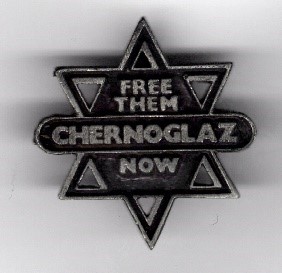
Fig. 15. Badge size 2.5x2.5 cm.
The author knows two prisoners of Zion with the last name Korenblit. To whom the badge depicted in Figure 16 is dedicated, the author does not know. Therefore, the author deemed it appropriate to include information about both in this note.
Professor Lev Korenblit was born in Bessarabia (Romania) on the 13th of June, 1922. At age 10, he became an active member of the youth Zionist organization Gordonia, involved in Zionist propaganda. In 1940, after the Soviet occupation of Bessarabia, he went underground, organizing groups that studied Hebrew and Jewish history. During WWII he served in the Red Army. In the 1960s he became a Zionist activist in Leningrad and was elected to the Committee of the underground Zionist organization of Leningrad. In 1969-1970 he was an editor of the "samizdat" journal. In 1970 he was arrested, together with the other members of the group, and in May 1971 at the 2nd Leningrad trial, he was sentenced to 3 years imprisonment in Mordovian camps. Released in 1973, he left for Israel within several weeks.
Michael Korenblit was born on November 4th, 1937 in Ukraine. He worked as a dentist in Leningrad. The Six-Day War in 1967 and anti-Semitism in the Soviet Union led him to become aware of his Jewishness and the ideal of Zionism. As an activist in the underground Zionist movement in the Soviet Union, he organized ulpanim for the study of Hebrew and the history of Jewish people, shared his knowledge of Zionism and the state of Israel with other people and also sent letters of protest to the Soviet authorities. Arrested in 1970 on the charge of Zionist anti-Soviet activity, he was sentenced at the 2nd Leningrad trial, in May 1971, to 7 years imprisonment in the Gulag. Released in 1977, he left for Israel in the same year.
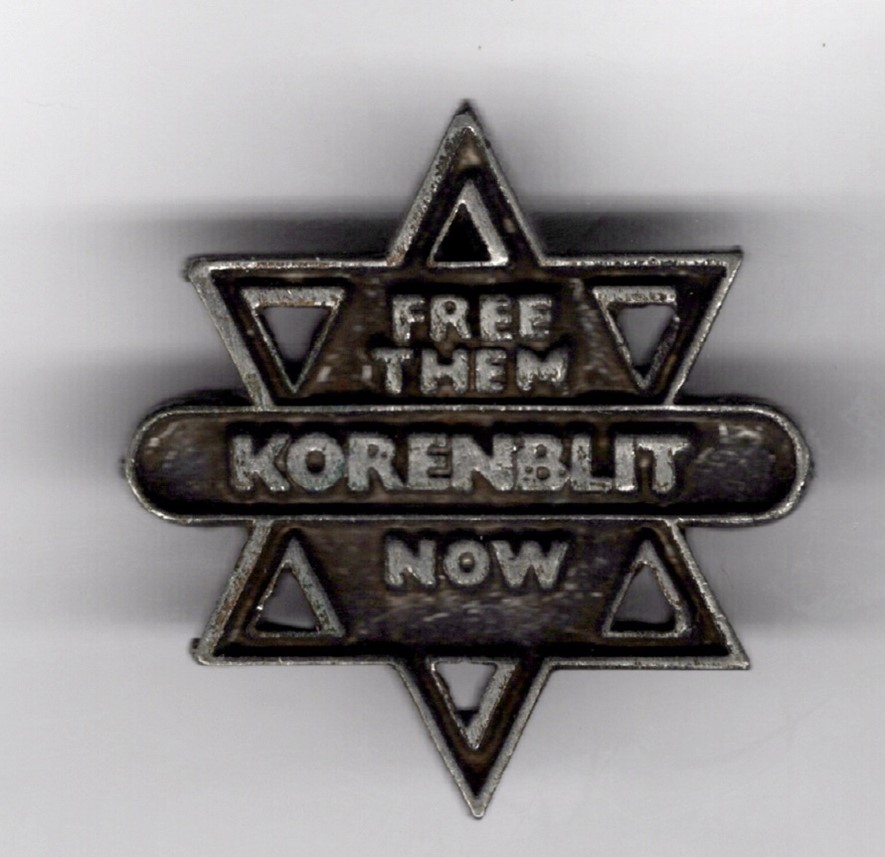
Fig. 16. Badge size 2.5x2.5 cm.
Ida Nudel was born in 1931 in Novorossiysk. Ida graduated from university with a degree in economics and worked in various Soviet institutions in Moscow and the Urals. In 1970, she applied to emigrate from the USSR to Israel, which led to her dismissal from work and being sentenced to exile on charges of “malicious hooliganism.” The “hooliganism” consisted of Ida hanging a poster in her apartment window demanding to be allowed to go to Israel. While in exile, Ida collected information about the Prisoners of Zion and transmitted it to the West. After a wave of protests in the West, her exile term was reduced to four years. In 1987, she flew to Israel.
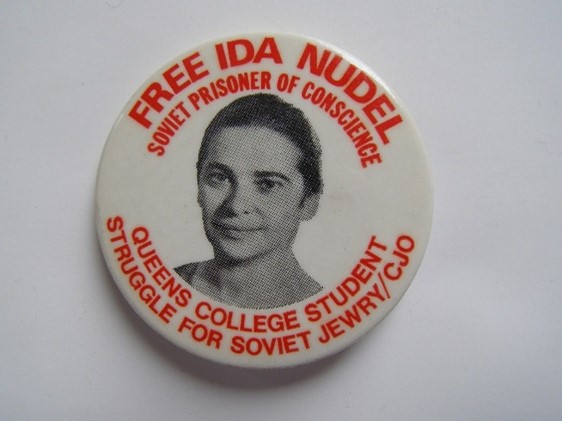
Fig. 17. The badge was issued by the organization “Student Struggle for Soviet Jewry” (SSSJ)
Alexander Yakir was born in 1955 in Moscow, into an assimilated family opposed to the existing regime. He first applied for permission to emigrate to Israel in 1973 with his family. The request was denied due to secrecy (his mother had level 2 access to classified materials). He applied again for permission to emigrate separately from his parents in 1977 but was refused without explanation. He began his Zionist activities in 1977 after receiving a second refusal. He participated in collective appeals to the U.S. Congress and foreign media. He was arrested on June 18, 1984, on charges of “evasion of conscription for active military service.” The court, held on August 10, 1984, sentenced Yakir to 2 years in a general regime labor camp. After his release in December 1987, he emigrated to Israel.
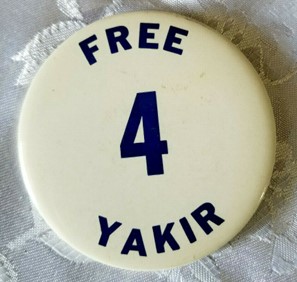
Fig. 18
Bibliography:
1. Michael Beizer, The Jews of Struggle: The Jewish National Movement in the USSR, 1967-1989 https://www.soviet-jews-exodus.com/English/JewishHistory_s/JewishHistoryBeizerExh_En.shtml.
2. V. Bernshtam, Let my people go. Medallions with the names of prisoners of conscience, “Shekel” v. 56, 4, p.19 – 33, 2023.
3. В. Бернштам, “Медальоны “Отпусти народ мой”. Нумизматика и Фалеристика, №3, с. 24 – 26, 2017.
4. М. Бейзер, В. Бернштам, Значки Центра информации о советском еврействе, Нумизматика и Фалеристика, №2, с. 37,2021.
5. М. Бейзер, В. Бернштам, Значки организации «Борьба студентов за советских евреев», Нумизматика и Фалеристика, №3, с. 32–34, 2021.
6. Бернштам В, “Натан Щаранський у медалях і значках“, “Тхiя”, №10, 2023.
7. V. Bernshtam, Let my people go Badges of Jewish Human Rights Organizations Issued at Summits with Soviet Leaders, “Shekel”.
8. Бернштам В, Значки єврейських правозахисних організацій, випущені до саміту з радянськими керівниками, Нумізматика і фалеристика, №3, с. 71–73, 2024.
9. Мероприятие в честь «Группы 35-и» – организации британских женщин, боровшейся за права советских евреев, Дата публикации 14.11.2019, Министерство премьер-министра, «Натив», https://www.gov.il/ru/departments/news/event-group-of-35-2019.
10. Zelda Harris, When Ingrid Bergman Ate a Soviet Labor Camp Dinner, https://blog.nli.org.il/en/ingrid_bergman_35.
11. Lesson plans and activities for educators about the Soviet Jewry Struggle, Refuseniks and Prisoners of Zion 1948-1991, https://en.nativ-education.org.il/lesson/protest-present.
12. Former Leningrad Mint Artist Creates Shcharansky "Prisoner of Conscience" Medal by Ed Reiter, The New York Times, August 7, Section 2, Page 28 - 29, 1983.
13. Soviet Jewish Human Rights Activists Awarded U~S- Congressional Go1d Medals by Jack H Fisher, Shekel XXII №2 p. 25, 1989.
14. "Remember and Save" Association, http://www.soviet-jews-exodus.com/English/index_En.shtml.